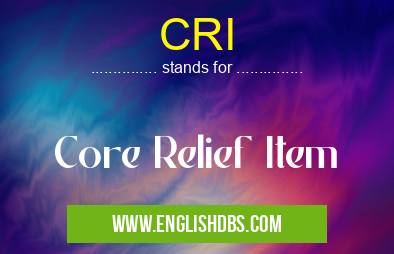What does CRI mean in UNITED NATIONS
CRI or Core Relief Item is a standardized term used in the humanitarian sector to refer to a set of essential items that are distributed to people affected by emergencies or disasters. These items are intended to meet the basic needs of individuals and families during the initial phase of a crisis, until more comprehensive assistance can be provided.

CRI meaning in United Nations in Governmental
CRI mostly used in an acronym United Nations in Category Governmental that means Core Relief Item
Shorthand: CRI,
Full Form: Core Relief Item
For more information of "Core Relief Item", see the section below.
CRI: A Standardized Approach to Emergency Response
The concept of CRIs was developed by the Inter-Agency Standing Committee (IASC), a global forum of humanitarian organizations, to ensure a consistent and coordinated approach to emergency response. The IASC has identified a core set of 11 CRIs, which are recognized and used by humanitarian organizations worldwide.
List of Core Relief Items
The 11 core relief items are:
- Blankets
- Sleeping Mats
- Kitchen Sets
- Water Containers
- Water Purification Tablets
- Soap
- Toothbrushes and Toothpaste
- Mosquito Nets
- Shelter Repair Kits
- Tarpaulins
- Tools
Importance of CRIs
CRIs play a vital role in the humanitarian response to emergencies by:
- Providing immediate relief to those affected by crises
- Maintaining human dignity and well-being
- Supporting the prevention of disease and other health risks
- Facilitating the transition to long-term recovery and development
Essential Questions and Answers on Core Relief Item in "GOVERNMENTAL»UN"
What is a Core Relief Item (CRI)?
A Core Relief Item (CRI) is a standardized essential item or service that meets the basic needs of individuals and families affected by humanitarian emergencies. CRIs are designed to provide immediate and critical support during the initial response phase of a disaster or conflict.
What are the different types of CRIs?
CRIs typically fall into several categories, including:
- Shelter (Tents, Tarpaulins, Blankets): Providing temporary protection from the elements.
- Water, Sanitation, and Hygiene (WASH): Ensuring access to clean water, sanitation facilities, and hygiene supplies to prevent disease outbreaks.
- Food: Providing nutritious food and supplements to prevent malnutrition and hunger.
- Health and Medical Supplies: Including essential medicines, medical equipment, and hygiene items for treating injuries and illnesses.
- Education and Child Protection: Providing educational materials, psychosocial support, and protection services for children and vulnerable individuals.
- Livelihood Support: Empowering affected populations to regain economic stability and self-sufficiency.
How are CRIs distributed and allocated?
CRIs are typically distributed through humanitarian organizations, government agencies, and local partners. The allocation of CRIs is based on a needs assessment that identifies the most vulnerable populations and the specific items required. CRIs are often prioritized for distribution to those who have lost their homes, are displaced, or are experiencing acute needs.
Who benefits from CRIs?
CRIs provide essential support to individuals and families affected by emergencies, including:
- Displaced populations: Those who have been forced to flee their homes due to disasters or conflict.
- Refugees: Individuals who have crossed international borders to seek protection.
- Internally displaced persons (IDPs): Individuals who have been displaced within their own country.
- Disaster victims: Those who have been affected by natural disasters or man-made crises.
- Vulnerable communities: Including the elderly, children, women, and persons with disabilities.
Final Words: The use of CRIs in humanitarian response ensures that those affected by emergencies receive the essential items they need to survive and recover. By standardizing the core relief items, humanitarian organizations can work together more effectively, reduce duplication of efforts, and maximize the impact of their assistance.
CRI also stands for: |
|
| All stands for CRI |
